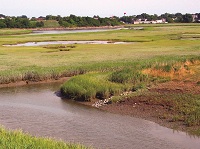Wetland Soils
What is a Wetland?

Wetland soils, like the name implies, are wet. They can be found anywhere in the world, from hot to cold, and can even form in deserts! Anywhere that water or snow sits in one place for long periods of time or soils that drain slowly can be wetlands.
Climate

Wetlands can be found in any climate, from the tropics, to the tundra (in summer). As long as soils remain wet, they can have very little precipitation, or a lot. If a lot of plants grow in this area, they die and sink to the bottom of the water. They decompose slowly, and often stay very dark in color (black). Otherwise, the soil is hydric, and is a dull grey color. These soils can often have spots of red, orange, blue, or green. All that is required is low lying areas that do not drain well. If this layer of decomposing plants is deep enough, the soil is called a Histosol.
Organisms
 There are over 200 species of birds that nest near wetlands. They also provide habitats for beavers, insects, water loving trees (mangroves, cypress, swamp maple), alligators, and fish galore. Wetland peat bogs are often harvested and dried to provide fuel that burns long and hot, like coal. Wetlands can be freshwater, saltwater, or brackish. Each different type has different species.
There are over 200 species of birds that nest near wetlands. They also provide habitats for beavers, insects, water loving trees (mangroves, cypress, swamp maple), alligators, and fish galore. Wetland peat bogs are often harvested and dried to provide fuel that burns long and hot, like coal. Wetlands can be freshwater, saltwater, or brackish. Each different type has different species.
Relief and Parent Material

Wetlands are depressions in a lands surface that are poorly drained. The parent material varies depending on location. However, most of them can have organic parent materials, which are made by decomposing plants and animals.
Time
Wetland can be newly created (because of construction activities elsewhere), or centuries old.
Special Issues in Wetlands

Wetlands help protect against flooding because they soak up and hold rainwater like a sponge. During heavy rains and hurricanes, the water spreads out slowly instead of rapidly running into rivers and streams. They also help clean out pollutants in rivers, lakes, and estuaries. However, they also can provide good farmland if they are drained. Lots of soils are also drained to make room for development. When these soils are drained, they shrink (like a sponge does when it loses water). This means that the soil can start to sink, up to two centimeters per year. This is faster than soils can form. Once these soils are dried out, they cannot go back to original condition.
Where are these Soils?
Wetlands encompass less than 1% of the worlds surface. Peat bogs have no water that flows through them. Along coastlines, there are marine marshes that tolerate high salt contents, including mangrove swamps. Freshwater marshes, swamps, and wetlands have properties of both land, and river systems, and come in a variety of sizes and regions.
For more information on wetlands, including downloadable PowerPoints, assessment questions, and educational links, please visit the SCOOP! Teachers Guide.



